Blue Spruce dying from bottom on up
Hey all - I have many Blue Spruce on my property and all seem to be dying from the bottom up. I thought lack of sunlight might be the issue for some that have become surrounded by bigger trees but even Blue Spruce's on their own with plenty of sunlight as affected. For some that had many clearly dead lower branches - I have been cutting the branches off. Is there a way to revive them? Is cutting the dead branches the best thing to do? I'm not painting the stubs after I cut them.
Thanks
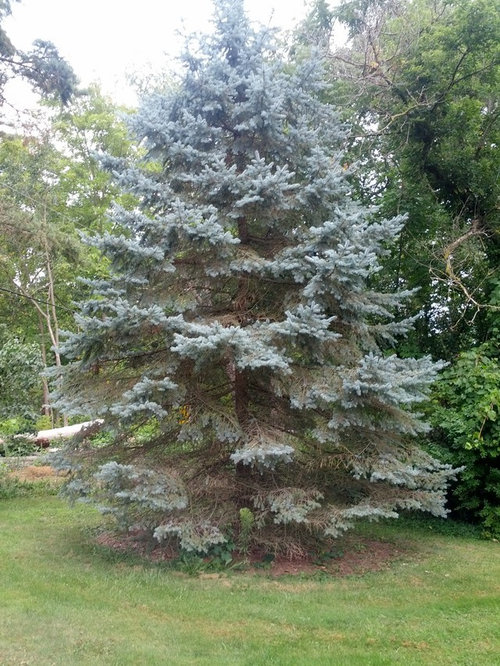
Comments (76)
sc77 (6b MA)
9 years agoStarting with smaller, container grown typically have a higher success rate. In MA you shouldn't have issues. I've actually found concolor growning in the woods in MA. They like it here, but need good drainage. If your failed, its was most likely due to poor draining or over watering.
davidrt28 (zone 7)
9 years agoOK, it's always good to cite sources. I stand corrected with regard to what those sources say...alas, sources can be wrong. Sometimes, very wrong. Even those from .edu -land. "Best fir for the east and midwest" is patently ridiculous, unless your definition is only areas north of a line between Chicago and Philadelphia. I have a 35' Abies concolor, in my yard, that just died because of the hot summers of 2010, 2011, 2012. If it were the "best" fir for the east, it would have survived that. And my 2 Abies firmas did, they thrived.
So sorry, I will be very skeptical until I see a picture of a large, healthy looking concolor in Tennessee. Heck, I'm pretty sure I've never seen a really good looking one in the greater DC area...and Tenn. is discernably hotter and more humid in summer, except in the mountains.A couple more obvious points: the relative paucity of most intermountain confers in the east, period. The habitat of Abies concolor is really not so different that Colorado Blue Spruce. Generally speaking the western conifers that grow well in the east are the exceptions to the rule. (and leyland cypress proves time and again it isn't one of the exceptions) Second, if they were groweable in the upper south, there would be a mature one at the NCSU arboretum; there is not. There's a dwarf that might have been grafted onto A. firma; JC Raulston was definitely one of the first to popularize that concept.
http://jcra.ncsu.edu/horticulture/our-plants/results.php?search=abiesSo, someone feel free to prove me wrong. Post a pic of a healthy Abies concolor anywhere south of Philly (where there are a handful of good looking ones, but they are by no means common; Nordmann fir is probably more common) or south of the Great Lakes-adjoining states.
Related Professionals
Reading Landscape Architects & Landscape Designers · Bridgetown Landscape Architects & Landscape Designers · Leawood Landscape Architects & Landscape Designers · Rossville Landscape Architects & Landscape Designers · Bethlehem Landscape Contractors · Middletown Landscape Contractors · Mooresville Landscape Contractors · Cerritos Landscape Contractors · Gainesville Landscape Contractors · Inglewood Landscape Contractors · Laguna Hills Landscape Contractors · Lake Zurich Landscape Contractors · Thonotosassa Landscape Contractors · West Orange Landscape Contractors · Ansonia Landscape Contractorsdavidrt28 (zone 7)
9 years agoSo, here's something to do. Longwood Gardens: standard of plant care as high as can be found in the western hemisphere. Go to Longwood's plant explorer and compare the pictures of their mature Abies concolors to their Abies nordmannianas. Tell me which one appears to be growing "best" on the east coast. It's a no brainer. Yes, if you have to have blue foliage, you will have to have the scraggly, anemic looking Abies concolors. But Abies nordmanniana and various other firs I remember seeing there look much healthier. I mean, how is this so hard to understand? The freakin blue foliage is adaptation to conditions that don't occur here. Unless a sudden continental uplift moves us to 5000' of elevation, it's always going to be true.
davidrt28 (zone 7)
9 years agothetman, SC77 has said before he's in an area with sandy rocky soil; surely not all of New England is that way? If you have heavier soil that sould explain why the Abies concolors were hard to establish.
In any case to clarify SC77, I'm sure Abies concolors to grow well for you in New England - other than not being able to deal with hurricanes which is obviously something they don't encounter in their home territory. But I just don't think they are common at all in places that got really hot, humid and wet. In fact now that I think about it, the place I've seen the most of them by far are the suburbs of Chicago. The classic Lake Forest mansion seems to always have one out front. Well, they can be hot and humid, but their averages are much more comfortable than Tennessee or even the southern tip of Illinois. Cairo is 89/69 Chicago O'Hare's only 84/64 and places near the Lake are probably cooler.sc77 (6b MA)
9 years agoI concede... my statement was made based on readings and not first hand experience. I have seen members of this forum talk about growing this species successfully in southern locations such as Alabama and N. Texas, but I think the key to success with this species is elevation in the warmer regions. Concolor dominates in the mountain ranges of Cali, Arizona, ect.. but that is because of the elevation. In NE we don't have elevation, but do have fast draining soil and cool night time temps, which must help in their success.
Although they do grow in the same habitat as Picea pungens, their preference for our conditions is much better. I have all but given up on growing Blue spruce successfully around here, but concolor, despite being non-native will actually grow in the woods around here randomly. I assume these have grown from seeds of ornamental trees planted by home owners, maybe dispersed by birds. Engelmannii is also considered nearly identical to blue spruce, but again, they do significantly better here than blue spruce. I thought these were just my observations, but later confirmed these findings in papers written by the Arnold Arboritum dating back to the early 1900's. In fact, they (incorrectly) predicted that Picea engelmannii would actually become the favorite ornamental tree instead of Blue spruce in years to come. That prediction was made in 1919.... but people continue to torcher themselves and plant Blue spruce that look good for a couple years before dying.
davidrt28 (zone 7)
9 years agoSC77...thanks, I did not realize that CBS was difficult as far north as Boston. I vaguely feel like i've seen them up there, but they would not be something I'd be looking for. I'd have to be literally hit in the head with one. The couple of times I've been at the Arboretum (Arnold!) I was admiring other things, like the Cedrus.
Another thing going on here is that perhaps recent climate patterns (I certainly would not call it "change" for what a short period I'm talking about, and also to avoid baiting people into a stupid OT digression) have made latent problems more serious. After all, as of let's say 7 years ago, my parents former house still had a couple health CBSs in front, planted on the highest part of the property, in northern Virginia. Even years ago I realized they were a lucky exception. This garden (my current one) had an Abies concolor that was reasonably healthy seeming in the front yard. Then there's the worst string of consecutive summers since the 1930s, of 2010, 2011, and 2012. Now a species that might have at least been "a fairly good choice" for the part of the east around Philly and DC, no longer is. The CBSs where I grew up are totally dead; my Abies concolor finally became a carcass as the last live bits of it died off this spring and I'll be cutting it down the next time I have my tree guy out. A friend who follows weather & climate told me he believes we might be in for an oscillation back to more reasonable summers for more than a decade, and this one could be the start of that. I certainly hope so.This post was edited by davidrt28 on Thu, Aug 14, 14 at 16:21
thetman
9 years agono- not all rocky in new england ( some parts) my ski was partial clay like- but green giants, nor ways, alberta spruces in the area all are thriving. so maybe just a bad batch. the white firs budded real nice that year but quickly started to brown out and then drop their needles quickly. I git credited for them from the nursery I frequent- but still it would have been nice.
davidrt28 (zone 7)
9 years agoWell, I have green giants and norways growing in the clayey-ist parts of my yard, and they love it. Granted the clay here is not the same as clay in DC and points south. It's brownish, loamy clay, not a red brick clay. But still, the Abies concolor would never put up with that. Whoever planted it back in the 70s or so was trying to do it right. They put it on one of the highest points possible in the yard. It just wasn't high enough when I had almost 40 inches of rain in the 40 days surrounding hurricane Irene in 2011. I think that was a big turning point for its decline.
bengz6westmd
9 years agoDavid, I've posted this Concolor before in Hagerstown, so you're prb'ly tired of it, but the point may be that it's on the top of a fair hill. Interestingly, there are limestone outcrops all around, but that doesn't mean the soil is alkaline -- generally it's still acidic other than on top of an outcrop:
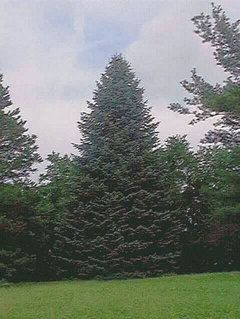
hairmetal4ever
9 years agoFew comments:
Conifer Kingdom also grafts some stuff on A. firma, at least last year they had started to.
I may try a concolor on firma myself.
I was in MA and NH earlier this summer and saw tons of ABSOLUTELY FLAWLESS A. concolors up there. BIG ones, too. Soils are pretty well drained, sandy loam for the most part, which I'm sure helps, plus the somewhat cooler summers. There were some nice CBS there too, but the concolors seem to look a bit better overall.
When I lived in OH - the CBS there declined after a while, too, and concolor did OK, but the heavier soils (compared to New England) probably weren't ideal. I seem to recall the dougfirs around doing better than either CBS or A. concolor in Ohio.
Final note: Stanley and Sons lists a Picea pungens x meyeri on their website. Has anyone ever tried one?
nwall45
9 years agoWe have 32 Norwegian spruces dying in our yard. My husband has been cutting them down. I tried to find out why starting 5-6 yrs ago and no one knew. The answer I received recently was from Ohio State ext.
It is called "Conifer Crash" and they aren't sure why. We did try spraying them a little in the beginning but of course they are too big and too many. Our Western Pines and Austrian Pines are also dying. Sad. We were in a beautiful secluded forest. Well, planning something new now.... as soon an he gets them all cut down.Sharon Quinn
8 years agoHave 40 yr old Blue Spruce - beautiful & healthy until about 4 yr ago. Die off starting at the bottom and now some healthy and some turning brown to about 10ft up. Had local horticulturist come, said we'll do an annual feeding and she sprayed it once a year in the spring but said I would eventually loose it. If I cut the lower branches off, do you think it might look good for another couple of years?? Am putting my home on the market next spring and would like it looking as good as possible.
wisconsitom
8 years agoYes, removing dead and/or dying branches is a quick way to immediately improve a plant's appearance. You seem to understand you're not curing anyything with this plan, but that it is purely cosmetic-OK-not purely, the branch removal would also be a part of any treatment plan-but for your purposes, yes, it should help. No guarantee there won't be new dead or dying branches to remove by this time next year, but so it goes.
+oM
ps........Hairmetal et al, correctly stated it is atmospheric moisture in the eastern US-not soil moisture-causing the greater proclivity of these Rocky Mtn. species to these various maladies. In their native haunts, they do not occupy extremely dry ridge tops and so on, but are more riverine in their preferences, tending to do best where there is sufficient soil moisture. But they can't take humidity like we get east of the Mississippi.
+oM
outback63 Dennison
8 years ago30-40 years is about max for home grown Picea pungens. Once they start die back cut it down. Don't spend money on "Conifer Crash".
wisconsitom
8 years agolast modified: 8 years agoAdditionally, these problems we're all talking about with especially Picea pungens are both old and new. The old part is Cytospora has been a well-understood problem with this plant for a long time, is eventually fatal, and there is no reasonable treatment. So too with Rhizosphaera needlecast....it's of long-term vintage, well-understood, and nothing new. But......what's happening with these and other spruce these days is on a whole new level. Ilovemytrees' recent linking up of us to that Michigan Phomopsis info is a case in point-nobody really new we had a Phomopsis problem on spruce until quite recently. Things are dynamic and whereas in my childhood-getting to be some ways back now, lol- it was commonplace to see very nice, completely healthy P. pungens everywhere, most of those trees are now either dead and gone, or soon will be. Things are changing in spruceland.
+oM
Mary4b
8 years agolast modified: 8 years agoMy tree has the same problem, it's cytospora and it has the white weeping, too. I posted and the folks here helped me last year to determine that I should probably cut it down. But, I did not. (To big to do myself, and didn't feel like spending my allocated garden money on it.) SO, when weather was dry, we limbed it up, which removed the worst part at the bottom. Now, a 8' person (hee-hee) could walk under it easily. This year, the tree looks much nicer to me...so much so, that I think I'm just going to keep it until it gives me another "sign". This time, I'll be ready with my bank account....errr, hopefully.
Mary4b
8 years agoI forgot to say, I'm very sorry for your loss. It's really hard to adjust to the loss of something so beautiful. And when it's also a habitat for critters, well, that just makes it more difficult. (Although dying/dead trees also make good habitat...)
wisconsitom
8 years agoAll, please do realize, this tree, which some say comes from an "arid" environment, will be stressed out by insufficient moisture. While atmospheric moisture, AKA high humidity, can indeed be a problem for Rocky Mtns. conifer species, this simply does not mean they are adapted to very dry soils. Nothing will set them up for failure like drought stress. So, if your area experiences drought, do consider watering your spruce trees.
+oM
jami_in_nys
8 years agoI live in Dutchess County, New York. I have noticed a RAPID increase in the death of Picea Pungens in this area over the last few years -- and I mean a rapid ACCELERATION of decline.
Something is most definitely going on with Spruces and it is most definitely NOT a matter of "Malnutrition." I have lived here my entire life (54 years) and I am an avid and very knowledgeable gardener -- I also have several spruce varieties on my property of various ages. In this area, I first noticed the symptoms on older, mature trees. However, I now see this problem is also OBVIOUS IN YOUNGER, NEWLY PLANTED trees. The problem is now prevalent in this area of New York -- everywhere you look.
I've also begun to notice similar symptoms on Spruces of other varieties such as Norway and White Spruce, as well as native Eastern Cedar. This truly breaks my heart, as these evergreens are such beautiful trees. I must concur with those who state that the East is no longer an appropriate climate (if it ever was) for this species -- particularly in light of climate change. The Blue Spruce decline is also highly prevalent in the upper Midwest. I've read that Spruces need a good, lengthy stretch of "cold" for dormancy in the winter, which this area no longer experiences (it once did). Please also note that we have NOT experienced "drought" in this area so I do not believe that is the problem.
Change in climate can bring about a variety of problems such as pests, blights, etc. This is happening with Pine Trees in the Rocky Mountains; Red Spruce Trees in the Adirondack Mountains of New York; Norway Spruce trees in German Bavaria, etc. No amount of feeding, spraying, etc. is going to cure this problem -- the only thing we can do is mourn the loss of these beautiful trees in our area.
I am also very familiar with "White Flower Farm" of Litchfield, CT. White Flower farm is a pretty place to visit, but it all flash and glamour (much like their catalog with highly touched up photos of the plants they offer.) White Flower Farm is ridiculously overpriced as they cater to a very wealthy demographic in their area. Simply because an employee of White Flower Farm gives you horticultural information, please do not take it as gospel. You are much better off discussing horticultural concerns with your local cooperative extension.
DOES ANYONE KNOW OF ANY EVERGREEN TREE (Other than White Pine) WHICH WILL STILL GROW HEALTHY AND WELL IN THE NORTHEAST AND MID-ATLANTIC REGION OF THE U.S.? Sadly, I am looking to replace my dying Spruce trees.
davidrt28 (zone 7)
8 years agolast modified: 8 years agoYes there are a lot of them. Various Asian firs, Picea abies of course, other pines, Cunninghamia in zn 7, etc. etc. It annoys me that the wan and sickly looking Pinus strobus are still planted in the mid-Atlantic. They really belong only where they are native IMHO. There are much better conifers for our area.
I have never seen a sick looking Picea abies here, so I don't know what you are seeing up there. Maybe a pathogen that needs cold winters LOL? Hope it stays up there.
wisconsitom
8 years agoAgree with davidrt...and therefore, to an extent disagree with you, jami, that Norway spruce is equally getting hammered by these pathogens. I'm not saying it is immune, but everywhere I've been looking-and I'm something of a spruce fanatic-Norway spruce alone seems to be doing better than any other spruce species. So, as convoluted as it may seem, given what you've posted, Norway spruce is the answer to your question. I'd also rate native genotypes of white spruce as the second-best option for the east.
Don Peters
8 years agoI'm in southern New Hampshire, and this area has abundant blue spruce trees. I've been following their decline for about 10 years now, due to symptoms as described by others. Other tree species also have similar problems. Shrubs too. Being curious, and an engineer, I decided to research this on my own. I had a tree care company come in and apply various fungicides. I also took numerous branch cuttings and examined them with a 400x microscope.
In my opinion, the problem is due to a new, unnamed, fungus, that reproduces with white spherical spores having a diameter of about 50 microns. This fungus grows under the bark, where you normally can't see it, in the tissue phloem. It is white in color (hence I call it "white canker") and hijacks the tree's nutrients, starving the tree as it continues to grow. I've documented all this extensively in a website I've produced. Unfortunately, I can't get plant pathologists interested enough to discuss these findings, in spite of the fact that these disease symptoms don't match the known pathogens that attack blue spruces.
Yes, I've found two chemicals that will combat this disease. You can apply them yourself, or have a professional tree care company do it. I've done both. The first antifungal chemical is called Mancozeb, and is applied to the foliage. The second chemical is called propiconazole, and while it is applied to the foliage, it is systemic. I have not yet tried injection into the trunk, as I don't have access to injectors. I've tried a "trunk drench", but that hasn't worked out well. I've also tried a ground drench with propiconazole. That often works initially, but then seems to damage beneficial bacteria in the ground, causing subsequent decline months later. Whatever fungicide is used, the treatment must be repeated about every 3 or 4 weeks during the growing season.
Unfortunately, when discussing this disease, I find huge amounts of speculation in the media, strong bias, but very little objective investigation. I'm hoping to change this, but so far haven't been very successful.
edlincoln
8 years agolast modified: 8 years agojami_in_nys: Eastern Red Cedar thrives here in Massachusetts...they never seem sick. I've seen some pretty healthy conifers that I think are concolor fir. And I would agree that Norway Spruce does great...I never see it looking sick. And since you said "evergreen" as opposed to "conifer" I'd throw in American Holly, ilex opaca.
bengz6westmd
8 years agolast modified: 8 years agoDon't notice any Norway spruce issues here at least, while blue spruces suffer chronic decline (with a few exceptions).
wisconsitom
8 years agoI say this only half-jokingly.....I submit we should anoint Norway spruce with "honorary native status"...and yes, I am lol'ing. But just a little.
jalcon
8 years agoHere in Southcentral PA most Colorado blue spruces don't look the best either. However, sometimes they do, as in this case, right up the street from me....a row of blue spruces all around 30' and look healthy. Maybe in 10-15 years it'll be a different story, idk.

in ny zone5
8 years agolast modified: 8 years agoI live in upstate NY, zone 5, and have 3 picea pungens. The dwarf p.p. 'Blaukissen' and 'St. Mary's Broom' are doing fine, planted them 7 years ago as probably 3 year old plants. But the 16+ years old p. pungens 'Glauca Procumbens' (trained upright) is losing lower limbs, but since its lower trunk is twisted anyway, it does not show much. So I should give the 'procumbens' an insecticidal and fungicidal spray bath...
Other of my piceas have no problems. The innermost needles simply fall down which seems to be natural, like at a 10+ ft Picea omorika 'Pendula Bruns', and as Eastern White pines do.
treetman
8 years agolast modified: 8 years agoI have not seen major damage to blue spruce heroes SE Mass. Red Pines have taken a serious hit. The oldest blue spruce I have is about 8 years old, they all still look good even though the tree service guy keeps telling me to trim the lower branches to keep them off the ground. to prevent fungus attack
Pine weevil is the only damage In noticed on my norways, eating the leaders. The bayer tree product seems to help with that. Last year the gypsy moth caterpillars were everywhere and did major damage to a lot of oaks and other trees. They also did major damage on my Bakeri spruce. found out the hard way if you touch them on your skin you get a nasty rash.
UMASS extension put out a warning about the southern Pine beetle that has been captured in MA but no serious damage yet but in other states like NY there has been mortality issues on Norways and other trees.
thetman
bengz6westmd
8 years agolast modified: 8 years agoThe further you go into cooler and/or less humid climates, the less damage to blue spruces.
sc77 (6b MA)
8 years ago@Jalcon, your photo shows, exactly what I have observed here as well. The best looking (very few) blue spruce are in situations where they are somehow planted high, meaning air can circulate really well up and under the lower branches to prevent the fungus that is almost guaranteed otherwise. They also need full 100% sun, as the ones in your photo look to have, since open air circulation and full sun.
@zzzuoh, I'm in MA and the blue spruce look terrible, with a few exceptions. They are so abundantly planted, that you can see a lot of nice looking ones while they are young, but I have only seen a few planted in perfect situations as described above that keep their lower branches and look healthy beyond 20-30ft tall. Maybe some of the dwarfs can do ok, but id says blue spruce is probably one of the most vulnerable conifers outside its native range.
Here is one of the best ones I have seen. I've even considered taking cuttings with the hope their is something unique in the DNA, but I think it's just the perfect planting location that allow it to stay so full and healthy.... It's going to swallow up the house soon tho!
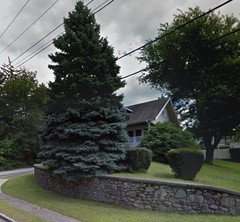
wisconsitom
8 years agolast modified: 8 years agoSame way here-you will see "perfect" ones but plenty of very diseased, shabby looking things too. I agree also that siting makes a big difference. Often, where they are crowded by others of their own kind or other vegetation, they will be doing especially poorly.
Of course, there are the outliers too-trees that have everything going wrong-too crowded, shade closing in....and still perfect! Darn nature. Why can't you be simple and neat?
sc77 (6b MA)
8 years agoYes! Those ones that are planted all wrong, but still look great are the ones propagators should be focused on! They must have something unique in their DNA that is preventing them from getting diseased. The problem is... it's such a long process to collect, graft, and grow for many years to see if it truly has any unique mutations... that's a lot of work to find out there was nothing special about it!
Now... if someone could scientifically identified a gene or some molecular mutation that makes some of them stay healthy... well then, we would be in business! haha
wisconsitom
8 years agoI agree with everything you just wrote there, except I'd substitute the word 'might' for 'must'....they might have some genetic something or other. We really don't know nor do we completely understand the pathogens. Just look at the "new" type of Phomopsis that is being found all over the place on these trees. Ten years ago, I never talked about Phomopsis as a serious pathogen of spruce. Juniper blight, sure, but spruce? Plus, pathogens, like all organisms, are on a march towards a future and have the ability to undergo genetic mutations along the way. So even if you think you've got the answer............you might not in five years. Fun stuff, I know!
vzetywh8
8 years agoWe live in SE Pa. Our 30 foot blue spruce (which we planted over 30 years ago) developed bag bugs, which we had professionally treated for five years along with injections of nutrients. Unfortunately it blew over in one of the fierce snowy wind storms in February. From the stump we could see that the trunk was showing signs of decay in the middle along with a root that twisted around the others.
I would like to plant another tree in its place, but heard the soil is now very acidic. What tree would be the best to use?
I
taramadison23
7 years agoFor those of you who suddenly have diseased trees and shrubs as well as struggling floral....please pay close attention to this information! Pines and Blue Spruces are particularly affected by this also, and no one is paying attention and catching on! Trees that are stressed easily succumb to all kinds of diseases and pests. On and around 2006, the utility companies started removing the analog meters (Water, Gas, and Electric) and replacing them with wireless meters. (AMR, AMI, ERT, Smart Meters). These meters emit damaging wireless frequencies and radiation (also known as ELF and EMF) throughout the ground and air. These frequencies have been labeled as a Class 2b carcinogen to humans and all the VALID RESEARCH has shown that the frequencies and radiation destroy the cellular tissue and immunity of all living things! The wireless water meters are damaging the root systems of the trees and plants. The accumulation of the above ground wireless meters in combination with the new 3G/4G cell towers are destroying the bark and leave systems of the trees. Not only are human, pets, and wildlife suffering severe diseases, heart attacks, fatigue, dementia, etc.. from these exposures, but the damage to the trees is catastrophic! The Vast Majority of arborists and other tree specialists are so busy misdiagnosing the problems that they are missing out on the cause of the whole disease process! The trees can not recover from anything when they are constantly radiated! You can spray and feed as much as you like, but the trees are dying anyway because we are allowing the installations of these wireless meters!
Look at the tree research and have some common sense! File complaints with your local Public Service Commissions, Consumer Protection Agencies, and Environmental Protection Agencies! If people don't start taking action, we will soon lose our food sources too!
Reference these:
https://www.youtube.com/watch?v=LIXwsAFvFDQ
https://www.youtube.com/watch?v=3fhAFLV9ikM
http://www.zengardner.com/dutch-study-suggests-wifi-killing-trees/
https://www.youtube.com/watch?v=FN36DAMPots
https://www.youtube.com/watch?v=lsuP_WBBr2ctreetman
7 years agolots of info thanks. but if its emf frequencies causes damage wouldn't tree near power lines be sick too. I just don't see this in my area. But everything I have read about smart meters has been bad.
Don Peters
7 years agoPure nonsense! And based upon unsupported speculation. TV and other services have been broadcasting on these frequencies since the late 1940s with no effect on trees. And with much more power. The disease under discussion has only appeared since about 2005 - I've been tracking it since then, and spent hundreds of hours researching it and documenting it. Take a look at the diseased tree tissue with a microscope at 400x and you will see that the problem is a fungus in the tree's phloem. It has no name, but I refer to it as "White Canker" (because it is white in color and is a canker). And, yes, there is a treatment for it if you are a homeowner.
calliehf
7 years agoHere in Bangor / Brewer Maine, we have a 27 year old Blue Spruce, that up until the record winter of 2014, was full and gloriously beautiful from top to bottom. Next to the driveway, the snow weighted the lower limbs to the ground for like 6 months. It had never ever been trimmed, so I'm wondering if constant contact with the soil caused it to contract the fungus described here. The included Feb. 2014 picture seems to show some thinning of the bottom section, so maybe it was already infected & the harsh winter accelerated its decline. I found this discussion today, thanks for everyone's input !!! Ours was planted 27 years ago when our youngest son was born, so it's like a family heirloom, we call it "Jordan's Tree." I cut all the dead & dying lower limbs this spring. It looks better but will never be as pretty, and it is only blue & fluffy at the top 1/3 of the tree. But we are encouraged that just this week it appears to be sprouting new green growth everywhere. I'm contemplating trying to accelerate that by applying fertilizer. Does anyone have any recommendations about what type of fertilizer or rate of application I should use?
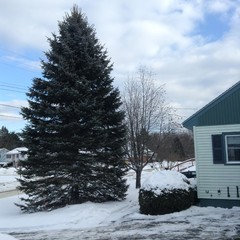
calliehf
7 years agoThe above picture is from Feb 2014, the one below is what the same tree looked like in 2010. I think the record 2014 winter ac
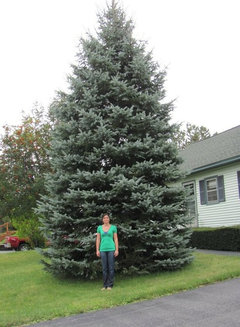
celerated its decline. I have since trimmed the lower limbs that you can see light through in the top snow picture.Don Peters
7 years agoYour blue spruce is showing the same symptoms that virtually all blue spruce trees have. If you've looked at these blue spruce trees over the years as often as I have, you may have noticed that you could never see the trunk of the tree - the foliage was that dense. With this disease, the tree sheds needles from the inside out and the bottom up, so the trunk becomes more and more visible as the years go by. Yes, people around here have also tried to treat the symptoms by trimming off the dead lower branches. But that doesn't help reduce the progression of the disease.
I believe the only way to save this tree is to call in a tree care company, and have them spray the tree with either Mancozeb or Propiconazole, and do it every 3 or 4 weeks during the growing season. You could buy a sprayer and try to do it yourself, but your sprayer might not be able to reach the top branches. I've done both.
calliehf
7 years agoThe tree is huge, & spraying probably is not an option. And it's my mother-in-laws tree, she is a cheapskate & will just say cut it down if I suggested spraying it..... One comment said fertilization worked for them, but every situation is different. The soil here is heavy gray clay & very nutrient poor, & fertilizer is cheap. But I know you are probably right, especially since we seem to be dealing with a fungus. But, the tree is not native to Maine, and getting older seems to lower its resistance to disease. Thanks for responding! I'm an avid gardener so I really have enjoyed reading about it, even though the diagnosis, solutions & probable outcome isn't what I wanted to hear !!!
treetman
7 years agocalliehf- funny you should mention the tree's constant contact with the ground. because I do have my trees sprayed-mostly maples for winter moth and recently the whole yard for gypsy catipillars. The tree service also mentioned that I should trim all the spruces so they do not make contact with the ground. first off- I have a lot of spruces- so that would be a lot of work. I also don't like the look of that either. I mean in the wild do all spruces get a fungus from touching the ground? he said all spruces, fat alberts, noways, blue etc. what are people's thoughts on this.
wisconsitom
7 years ago"In the wild" indicates a forest setting. There, the trees do indeed "self-prune" as lower branches become shaded out and lose their efficiency. The tree "knows" this and sloughs them off.
Incidentally, the notion that branches must be touching the ground for the various fungal pathogens to take hold is unsupported by evidence. Spores are microscopic, are floating in the air you are breathing right now, and need no direct contact to get where they get. Simply not true.
Nor is fertilization a part of this discussion. In particular, somebody above mentioned having nutrients injected into a tree that later failed in a windstorm. Hmmm....wonder if there's a connection? Not really, I'm near certain that there is. A huge blow-down of spruce once occurred throughout Germany and adjacent portions of other European nations. The trees that failed had all been fertilized. Watch that boys and girls...trees in nature rely on fungal partners (mycorrhizae) to acquire their nutrients, not a human monkey with a fertilizer spreader. You can do a lot of damage with good intentions.
Steve Paparatto
7 years agolast modified: 7 years agoIs there anyway to get blue spruce to regenerate lower branches? Or is that impossible? I am furious with my gardener. I had a beautiful blue spruce on my lawn for well over 20 years. The inner branches on the bottom layers started to turn brown, but they remained blue on the outside and didn't bother me. I came home 2 years ago to find that the gardener removed about 2 to 3 foot of branches from the bottom, because he said they were dry, and this was to protect the upper branches. End result, my beautiful Christmas tree form, now looks like a tree on a lollipop stick! I could cry. He says the upper branches will eventually droop and cover the ground again. In 2 years I have seen very little proof that that will happen. BTW I live in Suffolk County, Long Island New York.
davidrt28 (zone 7)
7 years agolast modified: 7 years ago"Is there anyway to get blue spruce to regenerate lower branches?"
No.
"I came home 2 years ago to find that the gardener removed about 2 to 3
foot of branches from the bottom, because he said they were dry, and
this was to protect the upper branches."Find another gardener, but don't plant another blue spruce. They last longer on Long Island than they do further south, but there are still better choices.
h_bvec
6 years agoI have 12 CBS about 40 years old and I can see the stem of the tree all the way up. A full 80 percent of the branches 15 foot up are either cut off or are partly bare of needles. I have not cut a branch that had needles. This is in central Minnesota (north and south), less than 10 miles from Wisconsin. These trees are completely open from east and west. I would guess these trees looked as good as any in the photos, maybe 15 to 20 years ago. I hope the wood has some value to offset the cost of cutting them down asap, but I doubt it.
davidrt28 (zone 7)
6 years agoWhile the thread is bumped, I wonder if Don Peters made any progress identifying the fungus he found.
Don Peters
6 years agoDavid, unfortunately my recent checks about a month ago weren't helpful in identifying this fungal pathogen, so it continues to devastate trees and shrubs. Not just blue spruce trees are affected, but so are maple trees and oaks, and people around here are having many of them cut down. Just last month my two neighbors had 5 of these large trees cut down. Mountain ash trees are dying too.
And I'd say that 50% of the white pines in this area (southern New Hampshire) are either dead or in decline from this disease. I don't spray mine since I consider them somewhat of a weed, and mine are slowly and continuously losing needles. I expect them to die within a few years.
The good news is that this year I've kept up spraying with Mancozeb every two weeks since May 1st. Every tree and shrub I've sprayed (where my spray can reach the foliage) is very healthy. I'm now also working on my grown son's 4 dying spruce trees to see if I can restart growth on the now bare trunk and on other branches.
But don't try a "ground drench" with Propiconazole - I tried that last year and it killed off beneficial ground bacteria, harming the trees & shrubs. Fortunately, they're recovering this year with fertilizer and spraying.
Norway spruce and linden trees seem to resist this disease best.
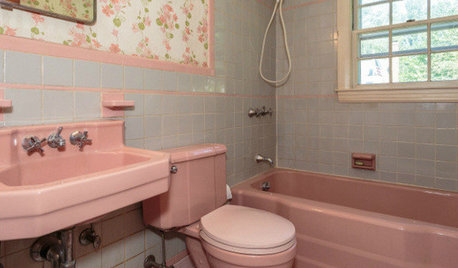


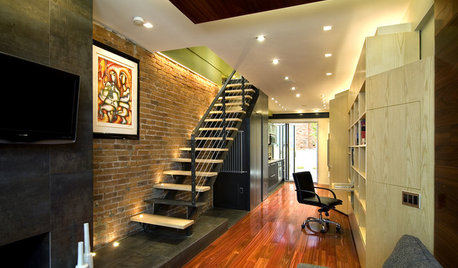
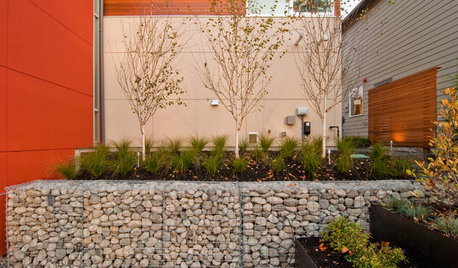











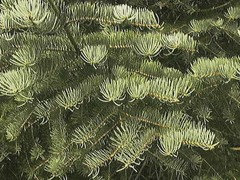



gardengal48 (PNW Z8/9)